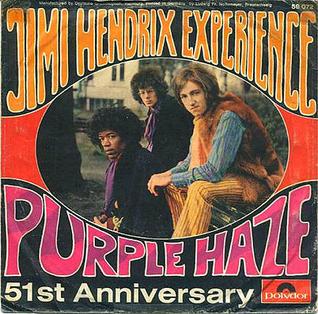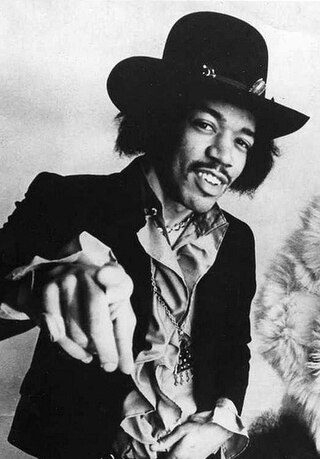Related Research Articles

James Marshall "Jimi" Hendrix was an American guitarist, songwriter and singer. Although his mainstream career spanned only four years, he is widely regarded as one of the greatest and most influential electric guitarists in the history of popular music, and one of the most celebrated musicians of the 20th century. The Rock and Roll Hall of Fame describes him as "arguably the greatest instrumentalist in the history of rock music."

Electric Ladyland is the third and final studio album by the Jimi Hendrix Experience, released in October 1968. A double album, it was the only record from the Experience with production solely credited to Hendrix. The band's most commercially successful release and its only number one album, it was released by Reprise Records in the United States on October 16, 1968, and by Track Records in the UK nine days later. By mid-November, it had reached number 1 on the Billboard Top LPs chart, spending two weeks there. In the UK it peaked at number 6, where it spent 12 weeks on the British charts.

"Purple Haze" is a song written by Jimi Hendrix and released as the second single by the Jimi Hendrix Experience on March 17, 1967. The song features his inventive guitar playing, which uses the signature Hendrix chord and a mix of blues and Eastern modalities, shaped by novel sound processing techniques. Because of ambiguities in the lyrics, listeners often interpret the song as referring to a psychedelic experience, although Hendrix described it as a love song.

Axis: Bold as Love is the second studio album by the Jimi Hendrix Experience. It was first released by Track Records in the United Kingdom on December 1, 1967, only seven months after the release of the group's highly successful debut album, Are You Experienced. In the United States, Reprise Records delayed the release until the following month. The album reached the top ten in the album charts in both countries.
"Little Wing" is a song written by Jimi Hendrix and recorded by the Jimi Hendrix Experience in 1967. It is a slower tempo, rhythm and blues-inspired ballad featuring Hendrix's vocal and guitar with recording studio effects accompanied by bass, drums, and glockenspiel. Lyrically, it is one of several of his songs that reference an idealized feminine or guardian angel-like figure. At about two and a half minutes in length, it is one of his most concise and melodically focused pieces.

Band of Gypsys is a live album by Jimi Hendrix and the first without his original group, the Jimi Hendrix Experience. It was recorded on January 1, 1970, at the Fillmore East in New York City with Billy Cox on bass and Buddy Miles on drums, frequently referred to as the Band of Gypsys. The album mixes funk and rhythm and blues elements with hard rock and jamming, an approach which later became the basis of funk rock. It contains previously unreleased songs and was the last full-length Hendrix album released before his death.

The Ultimate Experience is a 1992 compilation album of songs by American musician Jimi Hendrix. It includes 20 tracks spanning his career. The album was among the last to be supervised by interim producer Alan Douglas, before the Hendrix family regained control of his recording legacy. It has gone out-of-print and, in 1997, was replaced by the 20 track compilation Experience Hendrix: The Best of Jimi Hendrix.

South Saturn Delta is a posthumous compilation album by American rock musician Jimi Hendrix. Released in 1997 by Experience Hendrix, it consists of material such as demo tapes, unfinished takes and alternate mixes, and previously released material, most of which Hendrix had been working on prior to his death in 1970.

"Angel" is a song by American rock musician Jimi Hendrix, featured on his 1971 posthumous studio album The Cry of Love. Written and self-produced by Hendrix, he recorded it for his planned fourth studio album just months before he died in September 1970.
"Castles Made of Sand" is a song written by Jimi Hendrix and recorded by the Jimi Hendrix Experience for their 1967 second album, Axis: Bold as Love. Produced by manager Chas Chandler, the song is a biographical story about Hendrix's childhood, and was recorded towards the end of the production cycle for Axis: Bold as Love.

Jimi Hendrix (1942–1970) was an American guitarist whose career spanned from 1962 to 1970. His discography includes the recordings released during his lifetime. Prior to his rise to fame, he recorded 24 singles as a backing guitarist with American R&B artists, such as the Isley Brothers and Little Richard. Beginning in late 1966, he recorded three best-selling studio albums and 13 singles with the Jimi Hendrix Experience. An Experience compilation album and half of a live album recorded at the Monterey Pop Festival were also issued prior to his death. After the breakup of the Experience in mid-1969, songs from his live performances were included on the Woodstock: Music from the Original Soundtrack and More and Band of Gypsys albums. A studio single with the Band of Gypsys was also released.
"Have You Ever Been (To Electric Ladyland)" is a song by English-American rock band the Jimi Hendrix Experience, featured on their 1968 third album Electric Ladyland. Written and produced by frontman Jimi Hendrix, the song acts as the title track of the album, as well as essentially the opening track following the short instrumental intro "...And the Gods Made Love".

"Burning of the Midnight Lamp" is a song recorded by English-American rock trio the Jimi Hendrix Experience. Written by frontman Jimi Hendrix and produced by band manager Chas Chandler, it features R&B group Sweet Inspirations on backing vocals.

Loose Ends is a posthumous compilation album by American guitarist Jimi Hendrix, released in February 1974 in the UK. It was the fourth and last Hendrix studio album released posthumously by manager Michael Jeffery. The album features a collection of outtakes and jams, with the exception of "The Stars That Play with Laughing Sam's Dice" which is the sole authorized track by Hendrix, in a new stereo mix by Eddie Kramer.
"1983… " is a song recorded in 1968 for the third studio album, Electric Ladyland, by the Jimi Hendrix Experience. Written and produced by Jimi Hendrix, the song features flute player Chris Wood of the band Traffic, and at over 13 minutes in duration is the second longest track released by the group.
"Bold as Love" is the title track of Axis: Bold as Love, the second album by the Jimi Hendrix Experience. The song, which closes the album, was written by Jimi Hendrix and produced by band manager Chas Chandler.
"Are You Experienced?" is the title song for the Jimi Hendrix Experience 1967 debut album. It has been described as one of Jimi Hendrix's most original compositions on the album by music writer and biographer Keith Shadwick. The song is largely based on one chord and has a drone-like quality reminiscent of Indian classical music. It features recorded guitar and drum parts that are played backwards and a repeating piano octave. Live recordings from 1968 are included on The Jimi Hendrix Concerts album and Winterland box set.
"One Rainy Wish" is a song by the Jimi Hendrix Experience, featured on their 1967 second album Axis: Bold as Love. The song was written by Jimi Hendrix based on a dream that he had in which "the sky was filled with a thousand stars ... and eleven moons played across the rainbows," according to the song's lyrics. Shortly after the release of Axis: Bold as Love, "One Rainy Wish" was featured as the B-side to "Up from the Skies", released in February 1968.

"Hear My Train A Comin'" is a blues-based song written by Jimi Hendrix. Lyrically, it was inspired by earlier American spirituals and blues songs which use a train metaphor to represent salvation. Hendrix recorded the song in live, studio, and impromptu settings several times between 1967 and 1970, but never completed it to his satisfaction.
References
- ↑ "Burning of the Midnight Lamp" / "The Stars That Play with Laughing Sam's Dice" (Single notes). Jimi Hendrix Experience. Great Britain: Track Records. 1967. B-side label. 604007.
{{cite AV media notes}}: CS1 maint: others in cite AV media (notes) (link) - 1 2 3 4 Shapiro & Glebbeek 1995, p. 527.
- ↑ Geldeart & Rodham 2007, p. 35.
- ↑ Geldeart & Rodham 2007, p. 36.
- 1 2 Shapiro & Glebbeek 1995, p. 209.
- ↑ Shapiro & Glebbeek 1995, p. 210.
- ↑ Shapiro & Glebbeek 1995, p. 309.
- ↑ "Jimi Hendrix Experience - 'Burning of the Midnight Lamp'". Official Charts Company . Retrieved February 4, 2010.
- ↑ Shapiro & Glebbeek 1995 , p. 529
- ↑ "South Saturn Delta". The Jimi Hendrix Catalog. Experience Hendrix. Archived from the original on February 28, 2009. Retrieved February 4, 2010.